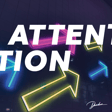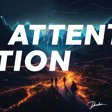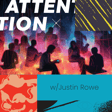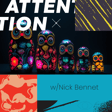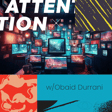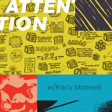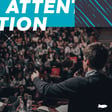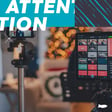Become a Creator today!Start creating today - Share your story with the world!
Start for free
00:00:00
00:00:01

Pay to Play: How to Advertise Your Way to Audience Growth w/Adam Shaw
In this episode, Dan Sanchez talks to Adam Shaw who is the Head of Demand Generation at Intentwise about paid media in audience growth.
You will:
- See how much budget to spend on paid for audience growth.
- Get some inspiration of what kind of creative to test.
- Grow your audience today with his best tip for getting started
You will:
- See how much budget to spend on paid for audience growth.
- Get some inspiration of what kind of creative to test.
- Grow your audience today with his best tip for getting started
Transcript
Introduction to Attention Podcast
00:00:10
Speaker
Welcome back to the Attention podcast. I'm Dan Sanchez with Sweetfish, and today I'm here with Adam Shaw, who is the head of demand generation at IntentWise. Adam, welcome to the show. Thank you very much, Dan. I'm excited to be here.
Choosing Paid Media Channels for Audience Growth
00:00:21
Speaker
For today's episode, I wanted to explore how paid media could be used to grow an audience, and Adam has some experience in doing just that. So to kick things off, Adam, what paid channels do you find work best for growing an audience?
00:00:35
Speaker
I think the page channel that's going to work the best is where your audience is. If your audience is very business focused, LinkedIn is going to be a great spot for it. If it's a little bit more of a relaxed kind of audience or maybe a direct-to-consumer-oriented audience, you might see TikTok, Instagram, Facebook. It's wherever your audience is. Makes a lot of sense. For most B2B companies, if you only had one place to go, maybe even if it was just intent-wise, you wanted to build an audience, whether it's an email list, podcast, where are you going?
00:01:01
Speaker
It's probably going to be LinkedIn for us and for a lot of people, depending upon what the budget is. You're really going to want to focus on just, like you said, one spot and go all in there and just be really good at
Allocating Media Budget Based on Audience Development Stage
00:01:11
Speaker
that. Absolutely. What percentage of media budget do you actually allocate just to audience growth and not towards lead generation or nurturing or whatever else you have going on?
00:01:21
Speaker
So it really depends where you are in the journey of building your audience. If you already have thousands and thousands of people in your community or in your audience that are dedicated to your brand, it's going to be a much smaller number for somebody who's really just trying to get out there. It might be as much as 50%.
00:01:37
Speaker
of your budget. Again, if you have a very expensive product or service, it's going to be replacing that brand awareness piece so you can lump in the brand awareness and the audience building into one that can get pretty high. What are some of the categories you would look at? If you're sitting down with a company, what do you look for in a company to determine where they're at? Do you look at company size? Do you look at industry? What kind of factors are you looking at as far as setting aside percentage of budget for that?
00:02:07
Speaker
looking to see how many people interact with them on a day-to-day basis, and not just by clicking on their blog posts or whatever it might be, but actually talking to them. So if they're their founder, or really whoever is kind of like the face, if their sales team is really the face of the company, I might look and go say, okay, is your sales team getting a lot of traction in your preferred space? So if it's LinkedIn, I'm gonna go see, are you guys actually generating commentary under your posts? Are your salespeople actually looking at other people's posts to see and comment under there?
00:02:34
Speaker
And if really we're not seeing a lot or maybe we're just seeing a ton of posting, but not a lot of traction, I think we need to have a conversation about A, the content and then B, how it's getting out there. And if they need to take basically any of their successful organic pieces and just kind of distribute it with some paid media, we'll start to see kind of what effect it has. You want to go slowly, right? You don't want to have to, you don't want to blow it out and find out you didn't really need to. And suddenly you wasted thousands of dollars when really you just needed a little extra push over the
Ad Budget Allocation for a Typical B2B Scenario
00:03:02
Speaker
edge.
00:03:02
Speaker
Cool. So let me throw out a scenario at you or what I think is like the typical scenario that I'm running into as an audience growth guy. B2B company, 100 employees, probably series A, series B, SaaS. They're making content. That's pretty good content. I'd say B content, not A plus, not C either. They have an in-house team creating content, but they're unhappy with their level of audience.
00:03:28
Speaker
They got an email list of a couple hundred people, some of its customers. They got some traction on social, couple hundred followers here or there. They got someone dedicated to doing social, but they want to do more. And they're wondering how much of their ad budget they have should be allocated.
00:03:44
Speaker
This is like the most typical scenario that I see when I'm talking to people and they run a growing audience. This is like the most common. Yeah, so if you're kind of that early stage startup with a pretty good amount of employees, I think that this, you probably already have a spend going somewhere else. I think that kind of falls into that general like 10 to 15% of budget going towards testing that a lot of paid media folks tend to do.
00:04:05
Speaker
especially if you're already spending like a million dollars a month or maybe even just a year. If you're not starting at zero, just call it your testing budget. If you're allocating 15% to AB testing, make your AB testing that, the audience building part. And that's your 15%, let it run for a couple months, see how it does, and go from there. Awesome.
00:04:26
Speaker
Now, what kind of creative do you typically run? Because when you're promoting a product, you run one type of creative, but now you're optimizing for audience. What kind of creative are you running? Yeah, I'm running whatever worked organically. I might just go in there and hit promote posts. It's super simple. So it's also very kind of on the fly. So if you have just an unbelievable post that happened, your CEO posted at 5 a.m. and by 7 o'clock, it's had 3,000 likes and 1,000 comments.
00:04:51
Speaker
I'm going to promote that. I'm going to put some dollars behind that and see what happens realistically to reach a couple thousand people, which is significant. You don't have to put a few bucks in. Especially it's super easy to do on like Instagram and Facebook. We can just hit promote posts, $5 for the next two hours, whatever it is. LinkedIn, pretty similar. You can promote posts to some degree. On paid, I do really like converting that.
00:05:12
Speaker
good organic content into video, it just grabs the viewer a little bit more. And if you're going to pay for it, you want to see if you can grab them a little bit earlier.
Leveraging Viral Content and Defining Virality
00:05:20
Speaker
It makes a lot of sense. So you just kind of wait for the viral hits to come and you're like, there we go. We have budget to boost that. Do you have any other systematic things you're looking for?
00:05:29
Speaker
Exactly. And so like my threshold for what's viral is extremely low, right? Like at least for, depending upon the size of your company, but viral to me is getting a ton of traction within your target audience. So if your target audience, if you have a hundred likes and 50 comments and every single like and comment is your perfect audience, then push that out. Because obviously it's doing really well. Then conversely, of course, if you have, you know,
00:05:55
Speaker
If you can see on LinkedIn, you can see how many people have viewed your posts. Obviously you can say, okay, there's 50,000 views, but only like 200 likes and 20 comments. And most of them are just like, yay, or great to hear, or super, you know, those aren't good. They're not like highly engaging. It's just people kind of commenting, just a comment.
00:06:12
Speaker
I consider virality to be something that's based on your baseline. So if you're usually getting a thousand views and you go from 10, then one post goes from 10,000 views to like somewhere between like 10X and 100X views. I'm like, that's viral, right? But it depends on your context, right? There's viral in the world's eyes and there's viral virality. And like, that's according to
Promoting Long-Form Content on LinkedIn
00:06:34
Speaker
you. Cause if you used to only getting 50 and you got a thousand, that's a pretty substantial change.
00:06:40
Speaker
Exactly. Again, it's like a useful virality. If I'm trying to sell a $10,000 a month product and a bunch of teenagers are reposting my stuff, really cool, awesome, kind of fun that we're reaching a different audience, but I'm not going to push that. You have to try to reach the CEOs or the CTOs or CMOs that are going to be purchasing a very expensive product.
00:07:00
Speaker
What if you're promoting something that's a little bit more long form with the creative? It's a podcast episode. It's a email newsletter. It's maybe a longer video of some kind. Where are you promoting it? So right now LinkedIn actually does pretty well I think with longer.
00:07:17
Speaker
It depends upon what exactly i guess you're trying to do so for linkedin if you have a great podcast episode like if this episode of attention ends up in the greatest episode in history you pull off a five minute piece of our conversation and then in the comment of the paid post you might say hey catch the rest here or catch us on the next one i like doing that i think that if you have really good content people are gonna stick around watch that for five minutes just like they would organically
00:07:42
Speaker
So essentially pull out a short video clip, maybe caption it, title it, and then just pull out the best clip of it. Don't tease it, just give away the best stuff or do you
Aligning Paid and Organic Content Strategies
00:07:50
Speaker
tease it? Yeah, I mean, just give it away. Look, just give away the best stuff. I'd rather have them hear that information than not, if that makes sense. If somebody says, that's really cool information, I don't have time to listen to the podcast. At least I still got it. And if you're going to tease them, I think
00:08:04
Speaker
I don't really see the value in that i think if the whole point is to get your information out there what's usually with the audience building it is kind of a combination right maybe it wasn't that time that capturing that demands to be part of the audience it wasn't that specific time for them. I think you have something about a longer blog post i wanna dress up because i think a lot of people get stuck in the let's just copy and paste the first paragraph of blog post summary.
00:08:27
Speaker
Literally, have your content people rewrite the blog post as a post. No copying and pasting. It's not going to work. There's a reason why people don't write 3,000-word LinkedIn posts. And there's a reason why Twitter is 240 characters, whatever it might be. Rewrite it for that specific audience and for that specific platform.
00:08:47
Speaker
Yep, and do you treat your creative the same way? Like the same kind of stuff you would normally post organically is the same kind of stuff you're running and paid when it comes to audience growth.
00:08:58
Speaker
Yeah. Yeah. So from an audience growth standpoint, that's probably the biggest part of it when I'm talking a little bit more about trying to get people to convert on something that might have a little bit of a different message, especially if it's a retargeting or depending upon what, you know, if there's a massive offer, you know, that, that, you know, week or month, depending upon, you know, how you, how you run your offers for your company. So, um, but I do like to kind of keep that the same, especially in LinkedIn, where it's not super simple, distinguished between what's paid and what's, what's not paid is, you know,
00:09:25
Speaker
If it's working as organic, why wouldn't it work to get the same job done? And if you think that your net new audience is going to be something that's going to capture intent for the next come by, I think you need to rethink your product unless you're selling socks that are really pretty and cool to look at. Nobody's going to be like, oh, I've never seen that before ever. I'm going to go fill it out to get the demo and purchase this $10,000 a month product. So if you're trying to capture demand on net new audience, I think you'd probably bark it up the wrong tree.
00:09:53
Speaker
So what's interesting about Facebook and LinkedIn is that their ad products are so close to what their content products are or their organic channels. So it looks pretty close. The one difference is, especially on LinkedIn, is when you have less copy to deal with and but you get a CTA.
00:10:10
Speaker
You get this bar across the bottom that you can actually add a CTA to. It's probably a button like subscribe, download, something like that. In general, what do you find the most effective CTAs when you get someone to subscribe or to view more? What are you testing and playing with there?
00:10:25
Speaker
So I think that if it's really a heavily content-focused piece of paid media, like not really trying to capture a man or elicit a purchase, being as specific as humanly possible in CTA, watch our next episode. Learn more about this episode. And if your situation where LinkedIn has pretty strict CTAs, like you can't just kind of go willy-nilly with a lot of them, add a CTA in the comment section to be more specific. And if you want to mention it in the promoted posts and content, do that.
00:10:55
Speaker
more information down in the comments or click the learn more button below. Awesome. Where do you send traffic?
00:11:02
Speaker
I send traffic to basically an extension of whatever the person is clicking on. So if it's a video, if it's a five minute video ad, which I think is now the longest you can do on LinkedIn, I'm gonna send them some more video content. Maybe it's the larger piece of that content, if it's something like that. Another thing is that I'd like to make sure that it's the same level of content. So to be a little bit more specific saying that
00:11:27
Speaker
If I'm selling a very technical product, I don't want to have a very high level piece of like top of funnel content be like the thing that's being posted and having paid me to behind and send them to an insanely technical, you know, white paper. It's just not going to work. I like to make sure it has the same tone of voice.
00:11:45
Speaker
It works the other way too. If somebody's clicking on a very technical ad, I don't want to send them to like top five ways that, you know, the top five post or something or a lead magnet using very like top of funnel or very low effort, I guess, commodity content for Black's Better Phrase.
00:12:02
Speaker
So where do you send them if you want them to subscribe? So they're going there to consume more content. Do you try to optimize that page with maybe a multitude of call to actions providing you're not being super annoying with your pop-ups or whatever? How do you think about that? Yeah, so all of our blog posts still have the same header as the rest of the pages. It's going to say, free demo now or free trial now. It depends upon who you are that's clicking on there, what the piece of content is.
00:12:31
Speaker
above the fold, there's going to be a subscribe now option. And I'll put one at the bottom of the post, and then I'll put a reactive message as well. So if the person goes to click back or X, you can set it to have a pop-up come up and say, hey, happy you read it.
00:12:47
Speaker
come check it out, subscribe, whatever it is, something that's super catchy, super clear. I try to be extremely clear with what's going to happen. You're going to click now, you're going to get one email a month or something, or if it's going to be more, just say it.
Current Audience Growth Tactics by IntentWise
00:12:58
Speaker
I try to be as clear as humanly possible so that they're ready for it and that they actually are getting content they enjoy. Because if they're not going to want to hear from us once a month, they're probably not going to be a good buyer anyway. For sure. Do you ever gate your content?
00:13:13
Speaker
Kind of. So the type of content that I like to get is stuff that basically has to be gated. So one thing that I'm kind of testing this a little bit is we're going to be doing kind of like almost little mini game shows for intent wise using Kahoot. I'm not sure if you're familiar with that platform. Absolutely. You have to enter your email in to use Kahoot.
00:13:32
Speaker
It's something that's worth it. It really has to be of super high value, which is to say you're actually interacting, you are learning something from it, and you can walk away and feel like you got away with doing something for free, basically. What does your audience growth tactics look like right now, as far as paid goes? What kind of campaigns are you running, and what are you trying to grow?
00:13:51
Speaker
Yeah, so we are about to launch a video series. We interviewed our CEO, our CTO, and our head of customer success. And they're just basically talking about the use of data in e-commerce. There are parts of it that get a little sales. You talk about our product, but the vast majority of it is all about data and how you can use it. One of our really bigger audiences are people who are media buyers, but not data.
00:14:19
Speaker
data scientists. So we want to be able to inform them about that and then come to us for questions. I want them to feel like, okay, I can go talk to intent-wise about data science questions. So it's really about reaching a new audience and telling them, hey, you can come to us. So that's the point with our video series that's coming out I think next week, I believe it starts. Nice. And so that's the video series. Where is it hosted and how are you sending, how are you promoting it and sending traffic to it?
00:14:46
Speaker
So the video series is chopped up to about five minute pieces on purpose to have paid on LinkedIn. It's going to point to larger, basically recorded webinars as well as live webinars in the series that are going to be coming, which they will live just on the website. Basically we'll put it on YouTube as well, just for ease of access for some people. We will also be interviewing high level tech folks to be able to then excite people to come and watch those webinars. And then of course,
00:15:15
Speaker
It's similar to what we did to get those five minute chunks. We'll edit those down into a little bit more consumer pieces and get them out organically and through paid. Cool. So you're running these five minute videos on LinkedIn. Call the action to see the full, is it the full video or is it just the next webinar? So I think that's going to be kind of A-B tested when it starts next week, because I want to see if the sign up now or watch full video is going to work better. Gosh.
00:15:38
Speaker
You should follow up with me and then I can make it into the email newsletter that follows this podcast. I'd like to know which one works better myself. Of course, what works for you might not necessarily work for me, but it'd be interesting to know. All right. My guess is that the watch the longer video will probably do better. Just get something that people can do right now.
00:15:57
Speaker
And yeah, I mean, signing up for a webinar is a pretty big ask, right? It's taking an hour of playing time out of somebody's day. But that's also, that person probably has a little bit more intent of using our product or has an interest in knowing more about our product anyway. So if it's a smaller group of more engaged people, that's perfectly fine for us.
Starting with Video Content for Engagement
00:16:13
Speaker
The last question, if somebody's listened to this now and they're like, I wonder where to start, what's like the lowest barrier, low hanging fruit that they can go and grab when it comes to paid media for audience growth?
00:16:23
Speaker
Go record a video of you saying something interesting and put money behind it on the platform that your people are on. Video content right now is obviously so far above and beyond anything else. It's super, super cheap to produce because you just need a... Everybody has a phone and just put a couple of bucks behind it. I think TikTok, you can literally put like a $2 behind a post and call it promoted. So give that a try. Nice. All right, Adam, thank you so much for joining me on the Attention Podcast.
00:16:49
Speaker
Where can people find out more about you and NtenWise online to learn more? Yeah. So NtenWise.com, our blog is full of a lot of really cool stuff. And then for me personally, everything for me is OMG, it's Adam Shaw. So my LinkedIn at the end of the handle is OMG, it's Adam Shaw, OMG, Adam Shaw. At TikTok OMG, it's Adam Shaw on Instagram as well, which I don't really post on Instagram, but if you want to follow me there, go ahead. Fantastic. Again, thanks for joining me on the show. Thank you so much.


